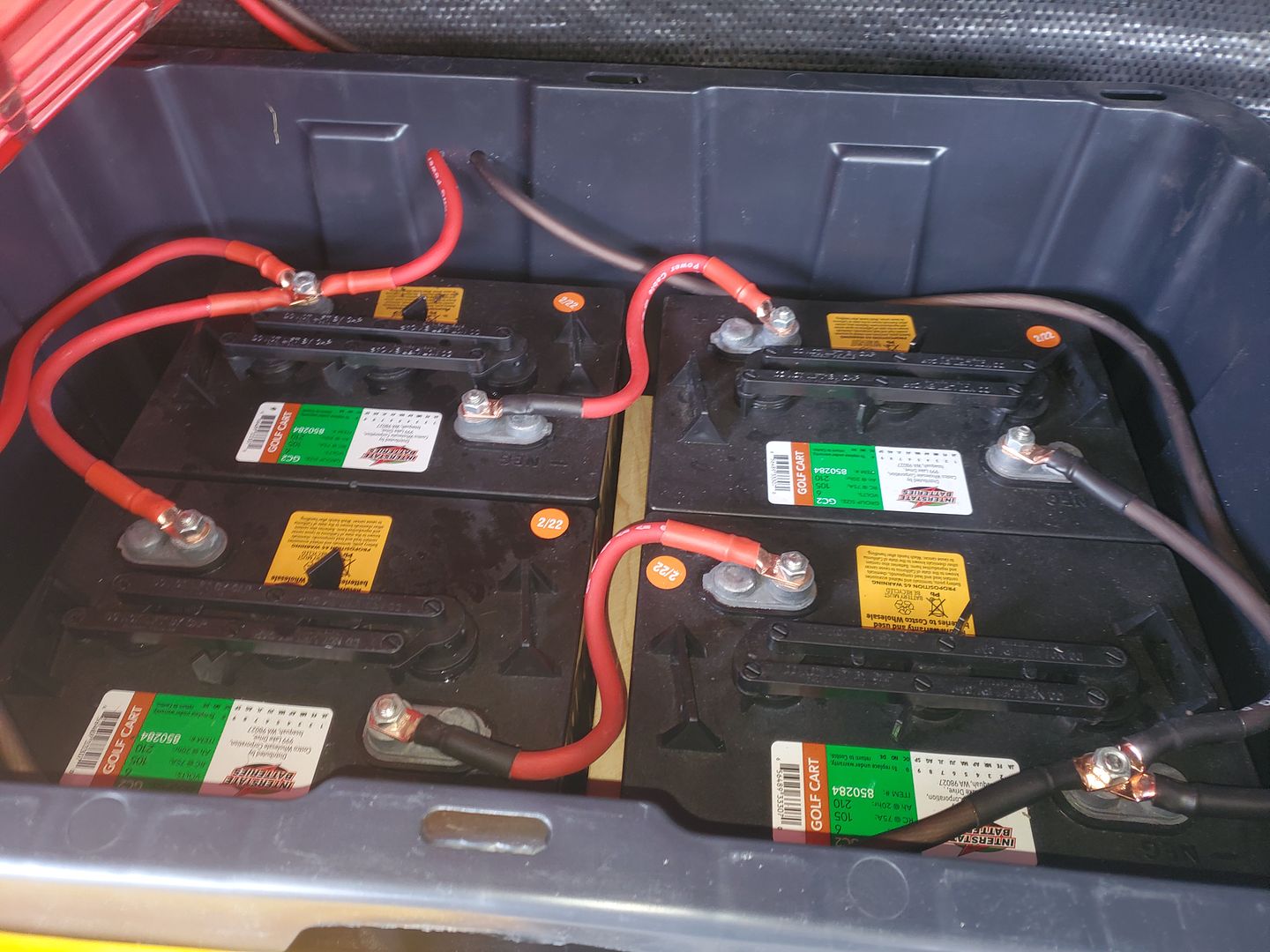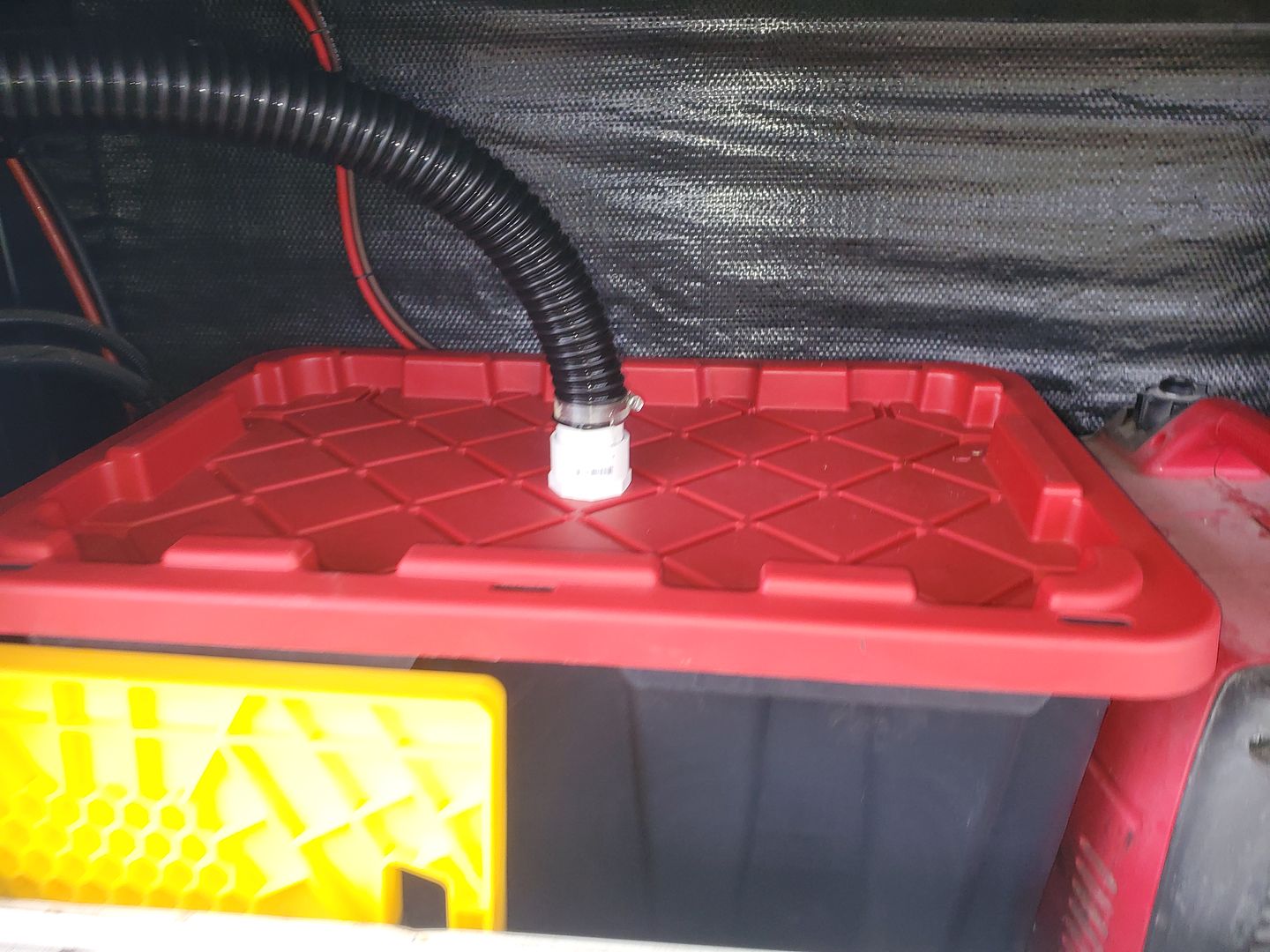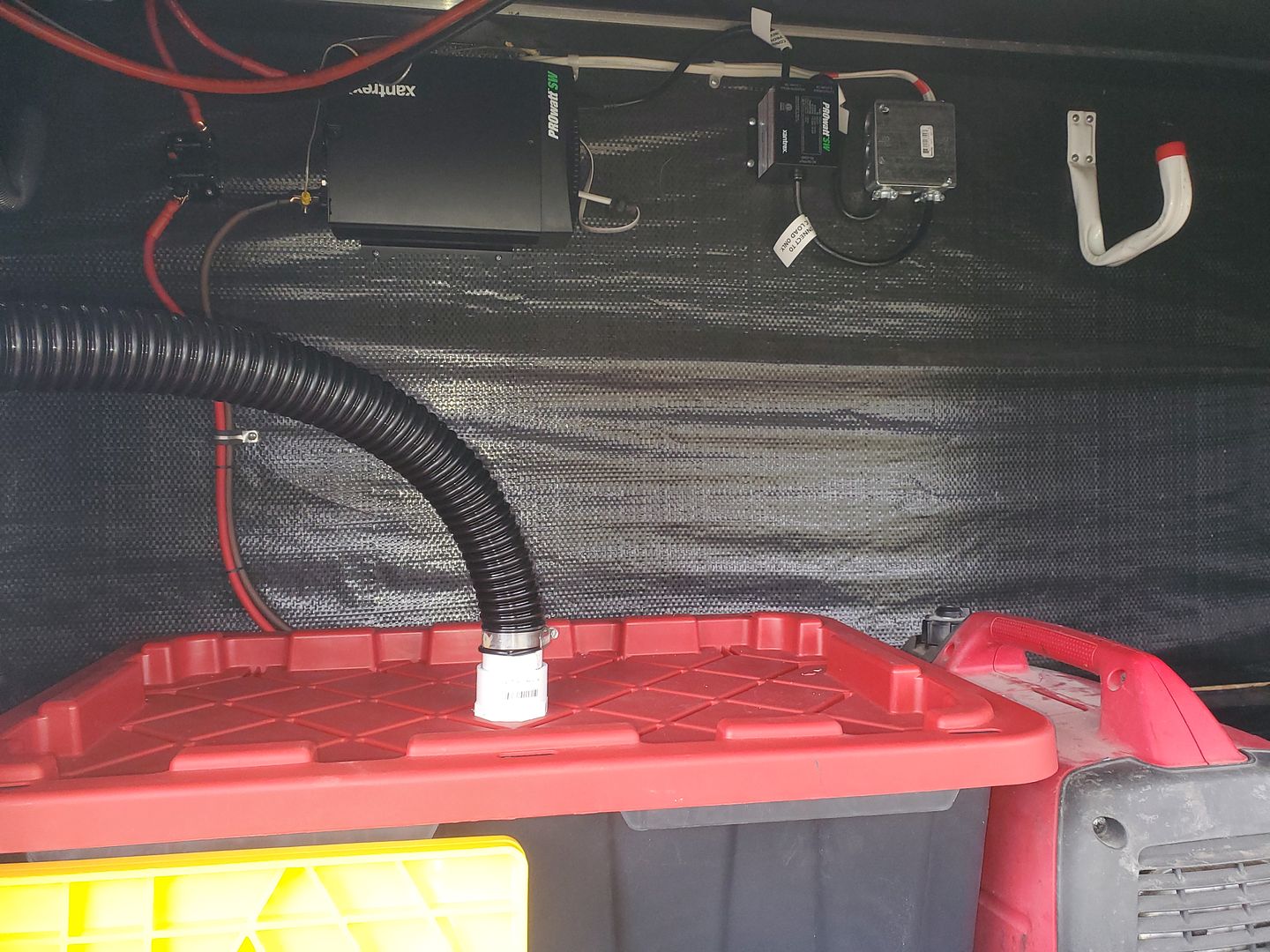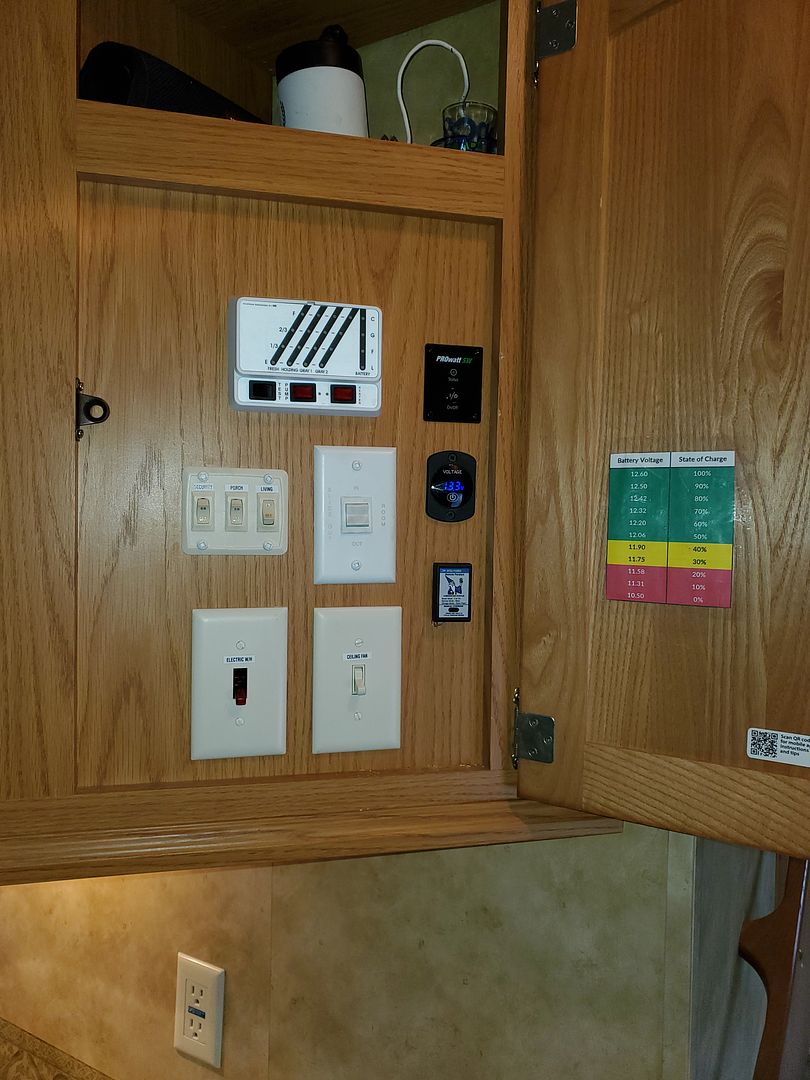- Good Sam Community
- Everything RV
- Technical Issues
- Batteries and Inverter Installed
- Subscribe to RSS Feed
- Mark Topic as New
- Mark Topic as Read
- Float this Topic for Current User
- Bookmark
- Subscribe
- Mute
- Printer Friendly Page
Batteries and Inverter Installed
- Mark as New
- Bookmark
- Subscribe
- Mute
- Subscribe to RSS Feed
- Permalink
- Report Inappropriate Content
Mar-27-2022 02:53 PM
So the trailer has a steel-floor compartment between the landing jacks and forward of the basement that the perfect spot. The camper was built with 1-12v batter in the forward curbside compartment with the jack hydraulics.
I stole the idea from another poster that commented on my other thread and found a plastic storage tub at the home center that would fit 4-6v batteries.

I used #4 wire between everything.
I added a vent hose and routed it to the original vent in the front of the trailer. I also added an intake at the bottom of the box with a hose that draws fresh air from below the floor.

I installed the Xantrax 600W inverter and 15a trandfer switch on the wall right above the batteries:

Inside I added the Xantrax remote, battery gauge and Progressive Charge Wizard to the switch panel by the door. The trailer already had a PD 9260 installed, so all I had to do was add the remote pendant.

- Mark as New
- Bookmark
- Subscribe
- Mute
- Subscribe to RSS Feed
- Permalink
- Report Inappropriate Content
Mar-31-2022 06:12 AM
I've been using amp hour monitors since the 90s when they were invented.
Here's the BMV-712 install I did in my previous RV
2018 Arctic Fox 992 with an Onan 2500i "quiet" model generator
- Mark as New
- Bookmark
- Subscribe
- Mute
- Subscribe to RSS Feed
- Permalink
- Report Inappropriate Content
Mar-31-2022 04:40 AM
Lantley the issue is the converter/charger...some cheaper OEM models will overcharge the batteries and that's what causes the water loss. This 5er has a Progressive Dynamics 9260 so I'm not worried about overcharging.
Checking batteries weekly is for the retired guys that need something to do....I check mine 2-3x per season and never had any issues.
BTW if you don't boondock, there's no need for this capacity. We like to camp at music festivals and they never have hookups and often prohibit generator use, so I like to get through a weekend on batteries.
- Mark as New
- Bookmark
- Subscribe
- Mute
- Subscribe to RSS Feed
- Permalink
- Report Inappropriate Content
Mar-30-2022 09:18 PM
Lantley wrote:
Currently I have AGM's and a small inverter powering a TV and nothing else.
Very simple install as I seldom boondock and I have a built in Onan 5500 if I really want power.
What had me questioning AGM vs. typical lead acid is the idea that water levels need to be checked once a week. If once a week monitoring is truly required, than it seems AGM's are the only way to go regardless of cost because once a week is a cumbersome task to me.
Before I went with AGM's I had lead Acid and I checked maybe 3-4 times a year at random intervals, But I was not running an inverter.
Is it that running an inverter necessitates weekly checks? Is it the size of the inverter and frequency of use that factors into weekly water checks?
Or are weekly water checks not necessary?
A small inverter has little or nothing to do with checking fluid levels on wet cells. What does is poor converters.
What size wattage is the inverter?
I had wet cells--but got tired of checking water levels laying down in snow.
My ride is a 28 foot Class C, 256 watts solar, 556 amp-hours of Telcom jars, 3000 watt Magnum hybrid inverter, Sola Basic Autoformer, Microair Easy Start.
- Mark as New
- Bookmark
- Subscribe
- Mute
- Subscribe to RSS Feed
- Permalink
- Report Inappropriate Content
Mar-30-2022 05:47 PM
Very simple install as I seldom boondock and I have a built in Onan 5500 if I really want power.
What had me questioning AGM vs. typical lead acid is the idea that water levels need to be checked once a week. If once a week monitoring is truly required, than it seems AGM's are the only way to go regardless of cost because once a week is a cumbersome task to me.
Before I went with AGM's I had lead Acid and I checked maybe 3-4 times a year at random intervals, But I was not running an inverter.
Is it that running an inverter necessitates weekly checks? Is it the size of the inverter and frequency of use that factors into weekly water checks?
Or are weekly water checks not necessary?
BD3,RV safepower,22" Blackstone
Ox Bedsaver,RV760 w/BC20,Glow Steps, Enduraplas25,Pedego
BakFlip,RVLock,5500 Onan LP,Prog.50A surge,Hughes autoformer
Porta Bote 8.0 Nissan,Sailun S637
Correct Trax,Splendide
- Mark as New
- Bookmark
- Subscribe
- Mute
- Subscribe to RSS Feed
- Permalink
- Report Inappropriate Content
Mar-30-2022 05:30 PM
Lantley wrote:
I'm no battery guru and I'm not challenging the advice given.
However, checking battery level weekly seems like a lot to go through.
In reality I can never see ME checking the battery level that often.
For that reason alone I would opt for AGM's.
I check my batteries 2 or 3 times a year if there new, begining of camping season end of camping season and once and a while 1/2 way through storage. if you have the factory WFCO converter it might be better to check them once a month, but a good quality charging system on new batteries shouldnt need that frequent of checking.
Steve
2016 Cougar 330RBK
1991 Slumberqueen WS100
- Mark as New
- Bookmark
- Subscribe
- Mute
- Subscribe to RSS Feed
- Permalink
- Report Inappropriate Content
Mar-30-2022 10:25 AM
TechWriter wrote:
OP, what breaker/fuse are you using between the batteries and inverter?
I have a 60a circuit breaker on the positive lead between the battery bank and the inverter. A #4 wire can actually handle more than 60a, but 60a @ 12v = 720W which is more than the inverter is rated for, so the inverter will shut down before the breaker pops in case of overload. The breaker is there to protect the wire in the event that the inverter malfunctions.
Xantrex states that #0 wire is recommended to minimize voltage loss over distance. They also have the same install guide for the 600w, 1000w, and 2000w models. Being that the inverter is ~3' from the batteries, voltage drop over distance was not a concern.
Lantley, the advantage to AGM is that they don't need to be vented, but also cost about double what you pay for a 6v GC2. The install worked out good for me because there was already accommodation for an external battery vent that I could connect to. Keeping the batteries in a storage bin not only supports venting but also keeps anything from accidentally contacting the battery terminals. I can store stuiff on top of the bin, it has a sturdy lid.
- Mark as New
- Bookmark
- Subscribe
- Mute
- Subscribe to RSS Feed
- Permalink
- Report Inappropriate Content
Mar-29-2022 06:50 PM
theoldwizard1 wrote:
You need to check the water in the batteries at least once a week. Hot weather and multiple discharge/charge cycle will cause evaporation. Depending on how much you use your RV, you probably need to clean the batteries every 3 - 6 months.
Our four FLA 6 volt golf cart batteries only use one pint each per year. We use our trailer 120 -150 days a year. They are seven years old and there is no corrosion on the terminals at all.
2004 32' Carriage 5th wheel. 860 watts of solar MPPT, two SOK 206 ah LiFePO4 batteries. Samlex 2,000 watt Pure Sine Wave Inverter.
- Mark as New
- Bookmark
- Subscribe
- Mute
- Subscribe to RSS Feed
- Permalink
- Report Inappropriate Content
Mar-29-2022 06:04 PM
However, checking battery level weekly seems like a lot to go through.
In reality I can never see ME checking the battery level that often.
For that reason alone I would opt for AGM's.
BD3,RV safepower,22" Blackstone
Ox Bedsaver,RV760 w/BC20,Glow Steps, Enduraplas25,Pedego
BakFlip,RVLock,5500 Onan LP,Prog.50A surge,Hughes autoformer
Porta Bote 8.0 Nissan,Sailun S637
Correct Trax,Splendide
- Mark as New
- Bookmark
- Subscribe
- Mute
- Subscribe to RSS Feed
- Permalink
- Report Inappropriate Content
Mar-29-2022 03:21 PM
Lantley wrote:
With that in mind what is the down side of using AGM'S Price?
IMO, yes, that's the only downside.
I'm not one to be terribly OCD about batteries. I probably do a better than average job maintaining batteries than alot of people, but not interested in treating them like your first newborn child!
AGMs just eliminate a maintenance issue, which in turn also makes them a better fit sometimes for "custom" applications.
2017 Heartland Torque T29 - Sold.
Couple of Arctic Fox TCs - Sold
- Mark as New
- Bookmark
- Subscribe
- Mute
- Subscribe to RSS Feed
- Permalink
- Report Inappropriate Content
Mar-29-2022 03:04 PM
2007 Tundra DC 4X4 5.7, Alcan custom rear springs, 2009 Cougar 245RKS, 370 watts ET solar, Victron BMV-712, Victron SmartSolar 100/30, 200AH LiP04 bank, ProWatt 2000.
- Mark as New
- Bookmark
- Subscribe
- Mute
- Subscribe to RSS Feed
- Permalink
- Report Inappropriate Content
Mar-29-2022 02:57 PM
Yes, the wet cells are cheap on the initial setup but over time are they a better way to go? My first AGM, a 4D case size, had a 215AH rating & gave a service life of 9 years. Every year it sat in storage for over six months with NO trickle charge or top up charge.
40+ night per year overnighter
2007 Alpenlite 34RLR
2006 Chevy 3500 LT, CC,LB 6.6L Diesel
Ham Radio: VP9KL, IRLP node 7995
- Mark as New
- Bookmark
- Subscribe
- Mute
- Subscribe to RSS Feed
- Permalink
- Report Inappropriate Content
Mar-29-2022 06:57 AM
Sam
Hurricane, Utah
2019 Winnebago Sightseer 33C
- Mark as New
- Bookmark
- Subscribe
- Mute
- Subscribe to RSS Feed
- Permalink
- Report Inappropriate Content
Mar-28-2022 10:03 PM
Lwiddis wrote:
Using #4 wire should mean close to no loss.
For a 600W inverter #4 is the minimum size. The Xantrex ProWatt 600 manual recommends 0 AWG (1/0) wire.
OP, what breaker/fuse are you using between the batteries and inverter?
2010 - 2021 Full Timer (41’ 2001 Newmar Mountain Aire 4095 DP - Cummins)
2021 - ??? Part Timer (31’ 2001 National RV Sea View 8311 - Ford)
www.rvSeniorMoments.com
DISH TV for RVs
- Mark as New
- Bookmark
- Subscribe
- Mute
- Subscribe to RSS Feed
- Permalink
- Report Inappropriate Content
Mar-28-2022 08:40 PM
Lantley wrote:
With that in mind what is the down side of using AGM'S Price?
A properly cared for flooded bank may outlast an AGM. It is hard to beat six volt golf cart batteries wired in series.
However the "properly cared for" means checking water levels regularly, always cycling to 100% state of charge, and keeping corrosion at bay.
AGM are more expensive than flooded. Like flooded, they should be recharged to 100% on every cycle.
I chose to move to reconditioned telcom batteries which are an AGM format.
My favorite battery is SiO2 which are a subset of AGM. That particular format does NOT have to be recharged to 100%, but should be fully recharged once every 30 cycles.
My ride is a 28 foot Class C, 256 watts solar, 556 amp-hours of Telcom jars, 3000 watt Magnum hybrid inverter, Sola Basic Autoformer, Microair Easy Start.





